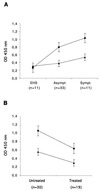Antibodies to an epitope from the Cha human autoantigen are markers of Chagas' disease
- PMID: 11687436
- PMCID: PMC96222
- DOI: 10.1128/CDLI.8.6.1039-1043.2001
Antibodies to an epitope from the Cha human autoantigen are markers of Chagas' disease
Abstract
Chagas' disease is a prevalent disease in South America that is thought to have an autoimmune etiology. We previously identified human Cha as a new autoantigen recognized by chagasic sera. Those sera recognized an epitope spanning amino acids 120 to 129 of Cha, named R3. In the present study we have used the synthetic R3 peptide for the detection of serum immunoglobulin G antibodies from patients at different stages of Chagas' disease, including a therapeutically treated group. The immunoreactivity with R3 by enzyme-linked immunosorbent assay (ELISA) showed 92.4% sensitivity and 100% specificity for Chagas' disease sera. This sensitivity and specificity were higher than for any other autoantigen described to date. No anti-R3 antibodies were detected in sera from Leishmania-infected or idiopathic dilated cardiomyopathy patients or healthy controls from the same areas. Moreover, anti-R3 antibody reactivity detected by ELISA correlated with conventional serological tests as indirect immunofluorescence and ELISA assays with Trypanosoma cruzi extracts and other diagnostic tests as indirect hemagglutination. The levels of anti-R3 antibodies increased with progression and symptomatology of Chagas' disease. More interestingly, a statistically significant fall in anti-R3 antibody titer was observed in patients treated with antiparasitic drugs. Those results suggest that the presence of anti-R3 antibodies is a highly specific marker of Chagas' disease and that R3 ELISA could be helpful in the diagnosis and monitoring of this disease.
Figures



Similar articles
-
Epitopes common to Trypanosoma cruzi and mammalian tissues are recognized by sera from Chagas' disease patients: prognosis value in Chagas disease.Acta Trop. 1996 Dec 16;62(3):151-62. doi: 10.1016/s0001-706x(96)00032-0. Acta Trop. 1996. PMID: 9025983
-
Dominant T- and B-cell epitopes in an autoantigen linked to Chagas' disease.J Clin Invest. 2001 Apr;107(8):985-93. doi: 10.1172/JCI10734. J Clin Invest. 2001. PMID: 11306602 Free PMC article.
-
High specificity of Trypanosoma cruzi epimastigote ribonucleoprotein as antigen in serodiagnosis of Chagas' disease.J Clin Microbiol. 1995 Jun;33(6):1456-60. doi: 10.1128/jcm.33.6.1456-1460.1995. J Clin Microbiol. 1995. PMID: 7650167 Free PMC article. Clinical Trial.
-
Molecular mimicry between Trypanosoma cruzi and host nervous tissues.Acta Cient Venez. 1992;43(6):330-40. Acta Cient Venez. 1992. PMID: 1343745 Review.
-
Humoral autoimmune response in Chagas' disease: Trypanosoma cruzi ribosomal antigens as immunizing agents.FEMS Immunol Med Microbiol. 1993 Oct;7(3):205-10. doi: 10.1111/j.1574-695X.1993.tb00400.x. FEMS Immunol Med Microbiol. 1993. PMID: 7506093 Review.
Cited by
-
Innate immune receptors over expression correlate with chronic chagasic cardiomyopathy and digestive damage in patients.PLoS Negl Trop Dis. 2018 Jul 25;12(7):e0006589. doi: 10.1371/journal.pntd.0006589. eCollection 2018 Jul. PLoS Negl Trop Dis. 2018. PMID: 30044791 Free PMC article.
-
Pathogenesis of chagas' disease: parasite persistence and autoimmunity.Clin Microbiol Rev. 2011 Jul;24(3):592-630. doi: 10.1128/CMR.00063-10. Clin Microbiol Rev. 2011. PMID: 21734249 Free PMC article. Review.
-
Recombinant antibody against Trypanosoma cruzi from patients with chronic Chagas heart disease recognizes mammalian nervous system.EBioMedicine. 2021 Jan;63:103206. doi: 10.1016/j.ebiom.2020.103206. Epub 2021 Jan 9. EBioMedicine. 2021. PMID: 33429173 Free PMC article.
-
The use of peptides for immunodiagnosis of human Chagas disease.Amino Acids. 2024 May 2;56(1):35. doi: 10.1007/s00726-024-03394-6. Amino Acids. 2024. PMID: 38698213 Free PMC article. Review.
-
Heat-killed Trypanosoma cruzi induces acute cardiac damage and polyantigenic autoimmunity.PLoS One. 2011 Jan 21;6(1):e14571. doi: 10.1371/journal.pone.0014571. PLoS One. 2011. PMID: 21283741 Free PMC article.
References
-
- Avila H, Sigman D, Cohen K, Millikan R, Simpson L. Polymerase chain reaction amplification of Trypanosoma cruzi kinetoplast minicircle DNA isolated from whole blood lysates: diagnosis of chronic Chagas' disease. Mol Biochem Parasitol. 1991;48:211–222. - PubMed
-
- Brener Z. Biology of Trypanosoma cruzi. Annu Rev Microbiol. 1973;27:347–382. - PubMed
-
- Britto C, Cardoso M, Monteriro Vanni C, Hasslocher-Moreno A, Xavier S, Oeleman W, Santoro A, Pirmez C, Morel M, Wincker P. Polymerase chaim reaction detection of Trypanosoma cruzi in human blood samples as a tool for diagnosis and treatment evaluation. Parasitology. 1995;110:241–247. - PubMed
-
- Caforio A L, Goldman J H, Haven A J, Baig K M, McKenna W J. Evidence for autoimmunity to myosin and other heart-specific autoantigens in patients with dilated cardiomyopathy and their relatives. Int J Cardiol. 1996;54:157–163. - PubMed
Publication types
MeSH terms
Substances
LinkOut - more resources
Full Text Sources
Medical
Molecular Biology Databases

